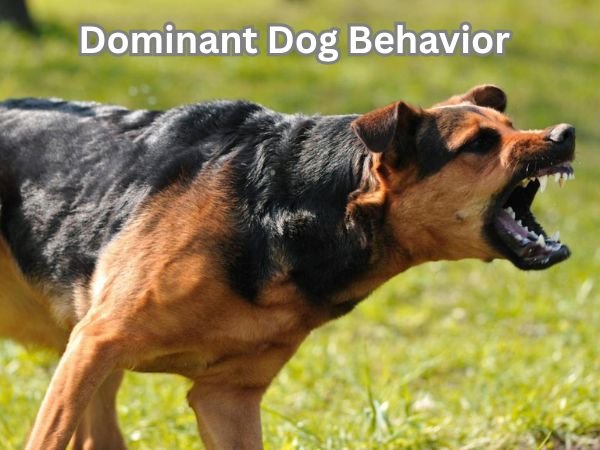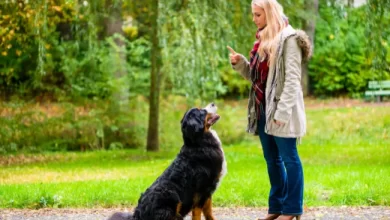
Dominant dog behavior is a natural part of how dogs communicate and establish their place within a social group. Understanding these behaviors is essential for any dog owner who wants to build a respectful and harmonious relationship with their furry companion. Yet, many owners unknowingly make mistakes that can unintentionally encourage or worsen dominance issues.
In this article, we will uncover the 10 shocking mistakes owners commonly make when dealing with dominant dog behavior and provide practical advice on how to avoid them. By recognizing and addressing these errors early, you can prevent conflicts and help your dog become a well-behaved, balanced member of your family. Whether you’re new to dog ownership or have years of experience, understanding dominant dog behavior is the first step toward positive change and mutual respect.
What Is Dominant Dog Behavior?
Dominant dog behavior is how some dogs show control or leadership in social situations. It’s about a dog trying to take charge within a group, whether with other dogs or even with people. This behavior comes from natural instincts tied to how dogs lived in packs long ago.
Signs of Dominant Dog Behavior
You can often tell if a dog is acting dominant by watching its body language and posture. Here are some common signs:
- Standing tall and stiff, making themselves look bigger
- Holding their tail high or straight out
- Direct, steady eye contact
- Raising their hackles (fur along the back)
- Mounting or placing paws on other dogs or people
- Moving in front of others or blocking their path
- Growling or snapping, but not always aggressive—sometimes it’s just a warning
It’s important to know that dominance doesn’t always mean aggression. Some dogs show dominance in calm, confident ways without fighting.
Dominance and Pack Hierarchy
Dogs are natural pack animals and understand a social order called a dominance hierarchy. In a pack, there’s usually a clear leader who others follow. Dominant dogs take on that top role by showing confident behavior, but good social groups have some balance between dominant and submissive dogs.
- Dominant dogs lead and guard resources like food or toys
- Submissive dogs show respect through behaviors like lowering their body, wagging tail, or avoiding eye contact
- This balance keeps peace in dog groups and helps them live together happily
Knowing the signs of dominant versus submissive dogs helps pet owners manage their pets better and build respectful relationships based on trust.
Why Dominant Behavior Develops in Dogs
Understanding why dogs show dominant behavior can help pet owners build better relationships with their furry friends. Dominant behavior is when a dog tries to take control in different situations. It’s important to know that this behavior isn’t about being “bad” but about natural instincts or learned actions.
Causes of Dominant Behavior in Dogs
Several factors play a role in why are dogs dominant, including:
- Genetics: Some breeds are more likely to show dominant traits due to their natural instincts.
- Upbringing: How a dog is raised early on influences their behavior. Poor socialization can lead to dominance issues.
- Owner Mistakes: Inconsistent rules or unknowingly rewarding bossy behavior can encourage dominance.
- Lack of Training: Without clear guidance, dogs might try to lead instead of follow.
- Breed Tendencies: Certain breeds have stronger protective or territorial instincts that can look like dominance.
Psychological and Environmental Influences
A dog’s mind and surroundings also matter:
- Stress or fear can make dogs act more dominant to protect themselves.
- Living in a chaotic or unstructured environment can cause confusion and dominance attempts.
- Dogs need clear leadership and routine to feel safe and balanced.
By understanding the causes of canine dominance, owners can provide better care and training to help their dogs feel confident and calm. Remember, patience and consistency are key to managing dominant behaviors in a loving way.
The Importance of Addressing Dominant Behavior
Dominant behavior in dogs can sometimes cause challenges at home. When a dog tries to assert control, it might seem like harmless stubbornness, but ignoring it can lead to bigger problems. It’s important to recognize and address dominant traits early for a happier, safer household.
Risks of Ignoring Dominance
- Escalation: What starts as simple pushiness can grow into more serious issues.
- Aggression: Dominance aggression can emerge, risking bites or fights.
- Household Stress: Tension rises when a dog challenges family members, affecting everyone’s peace.
Benefits of Early Intervention
- Easier to Train: Addressing dominance early makes correcting dominant dogs simpler.
- Stronger Bond: Your dog learns respect and trust, enhancing your relationship.
- Safer Home: Early action reduces aggressive behavior and creates a calm environment.
If you notice your dog showing dominant signs, don’t wait. Taking steps to guide and correct dominant dogs will protect your family and help your pet become a well-mannered companion. Remember, patience and consistency are key to success.
The 10 Shocking Mistakes Owners Make
1.Dominant Dog Behavior: Ignoring Early Warning Signs
When it comes to understanding your dog’s behavior, paying attention to early warning signs of dominance is key. Ignoring these subtle cues can lead to bigger issues down the road. Here’s what to watch for and how to respond.
Subtle Cues to Notice
- Pushing Ahead: Your dog may try to move in front of you during walks or crowd you for attention. This isn’t just excitement—it’s a way of trying to take control.
- Growling: Even low, quiet growls are a signal that your dog feels challenged or wants to assert dominance. Don’t brush them off as harmless.
- Controlling Resources: Dogs may guard toys, food, or even your personal space. If your dog becomes possessive or protective over these, it’s a sign of dominant behavior.
Why You Shouldn’t Ignore Them
Ignoring these early signs can result in your dog becoming more aggressive or harder to manage. Addressing them early helps maintain a healthy relationship and a happy home.
What You Can Do
- Stay calm and consistent—set clear rules about behavior.
- Gently correct pushing or resource guarding with positive training techniques.
- Redirect growling by identifying triggers and working to desensitize your dog.
Remember, your dog isn’t trying to be difficult—they’re communicating their needs. Paying attention early keeps your bond strong and your dog well-behaved.
2.Allowing the Dog to Dictate Household Rules
Many pet owners love their dogs so much that they let them call the shots at home. While it might seem cute to let your dog decide when to eat or where to lounge, this can lead to some tricky behavior. Here’s what you need to know about dominant dog behavior in the household.
Meal Times: Who’s in Charge?
- When dogs set their own meal times, they may start demanding food whenever they want.
- This can lead to begging, anxiety, or even overeating.
- Instead, keep a regular feeding schedule and stick to it.
- Consistency helps your dog feel secure and understand the rules.
Claiming Prime Spots
- Allowing your dog to claim the best spots in the house, like the couch or your favorite chair, can make them feel like they are the boss.
- This might cause jealousy or challenges to your authority.
- Set clear boundaries about where your dog can and can’t go.
- Provide a comfy bed or spot for your dog to relax that feels special and safe.
Why Boundaries Matter
- Dogs thrive with structure and clear rules.
- When you’re the leader, your dog feels calm and knows what to expect.
- This reduces stress and stops dominant behavior from taking over the home.
Remember, loving your dog means guiding them with kindness, not letting them rule the roost. With a little patience and clear rules, your home can be peaceful and happy for everyone.
3.Being Inconsistent With Rules and Boundaries
When it comes to dominant dog behavior, one common challenge is being inconsistent with rules and boundaries. This can cause confusion for your dog and make it harder for them to understand their place in the family pack.
Sending Mixed Signals
Dogs look to us for clear guidance. When we send mixed signals, like allowing a behavior one day but scolding it the next, dogs get puzzled. For example, if jumping on the couch is allowed sometimes but not others, your dog won’t know which rule to follow. This inconsistency can make them test limits more often.
Undermining Authority
If you don’t stick to rules or allow your dog to bend them without correction, it can undermine your authority. Dogs need to see us as steady leaders to feel secure and balanced. Without that, they may try to take control themselves, leading to dominant behaviors like guarding toys or demanding attention.
Tips to Stay Consistent
- Set clear, simple rules everyone in the household follows.
- Use the same commands and consequences every time.
- Be patient but firm—consistency builds trust.
- Don’t give in to begging or attention-seeking if it breaks your rules.
- Celebrate progress to encourage good behavior.
By staying consistent and clear, you help your dog feel safe and know what’s expected. This keeps dominant behavior in check and strengthens your bond.
4.Lack of Proper Training and Leadership
When a dog shows dominant behavior, it’s often because they don’t have clear guidance from their owner. Without proper training and strong leadership, dogs can feel confused about their place in the home.
Why Clear Expectations Matter
- Dogs look to their owners for rules. If these rules are unclear or inconsistent, dogs may try to take charge.
- Setting boundaries helps dogs feel secure. Without limits, they might act out or compete for control.
The Role of Strong Pack Leadership
- Think of your dog as part of a family pack. The owner should be the calm, confident leader.
- Weak leadership can make dogs anxious and cause them to test limits.
- Showing calm confidence helps your dog relax and follow your lead.
How to Lead Effectively
- Be consistent: Use the same commands and rules every day.
- Reward good behavior: Praise and treats help your dog learn what you expect.
- Stay calm and patient: Dogs respond best to kindness, not yelling.
- Set routines: Regular feeding, walking, and playtimes create structure.
Remember, helping your dog understand their place through clear expectations and kind, confident leadership will reduce dominant behavior and build a happier, healthier bond.
5.Dominant Dog Behavior: Failing to Socialize the Dog
When dogs don’t get enough social time, they can develop something called defensive dominance. This means they act tough or bossy because they feel unsure or scared.
Why Failing to Socialize Causes Problems
- Dogs need to meet other dogs and people. It helps them learn to be calm and friendly.
- Without this practice, dogs may feel lonely or nervous.
- This nervousness can make them act dominant to protect themselves.
What Defensive Dominance Looks Like
- Growling or barking when someone gets close.
- Blocking doorways or space to keep control.
- Stiff body language, showing they’re tense or on alert.
How to Help Your Dog Avoid This
- Start socializing early with friendly dogs and kind people.
- Take your dog on walks where they see new places and faces.
- Reward calm and relaxed behavior with treats or praise.
Remember, helping your dog feel safe and included is the best way to keep dominant behavior from taking over. A well-socialized dog is a happy, confident companion.
6.Rewarding Demanding or Pushy Behaviors
When your dog acts demanding, like pushing for attention or mounting, it can feel frustrating. It’s important to understand how your reactions can either encourage or discourage these actions.
Rewarding Demanding Behaviors
- Dogs learn that being pushy gets results when you give them attention, even if it’s to say “no.”
- For example, if your dog barks nonstop until you look at them, your attention acts like a reward.
- Try to stay calm and avoid reinforcing the behavior by only giving attention when your dog is calm and polite.
- Instead, reward good behavior with treats or praise to encourage better ways of asking for attention.
Reinforcing Attention-Seeking or Mounting
- Mounting can be a way for dogs to show dominance or seek attention.
- If you react by pushing your dog away or scolding, your dog might see it as a game and keep doing it.
- Redirect your dog to a toy or command like “sit” to change the focus.
- Reward your dog when they stop mounting or settle down to encourage positive behavior.
Remember, staying consistent and patient helps your dog learn the right way to get attention. Gentle guidance turns pushy behavior into positive communication between you and your pet.
7.Not Recognizing Dominance-Related Aggression
Understanding your dog’s behavior is key to a happy home. Sometimes, dogs show aggression because they are trying to be dominant. If you don’t recognize this, you might miss signs that your dog is uncomfortable or trying to take control.
Dogs may growl, snap, or stiffen when they feel threatened or want to assert dominance. These are not just bad habits—they are clear signals. Ignoring these signs can lead to more serious problems later.
Misattributing Aggressive Responses
It’s easy to mistake dominance-related aggression for other causes. For example, a dog barking at strangers might simply be protective, but it could also be showing dominance over its territory.
Here are some common mix-ups to watch for:
- Thinking your dog is just “playful” when it’s actually setting boundaries.
- Blaming anxiety or fear for behavior that comes from wanting control.
- Assuming the dog is being “bad” rather than communicating a need.
What You Can Do
- Pay close attention to your dog’s body language. Tail position, eye contact, and stance offer clues.
- Stay calm and consistent with training. Dogs respond best to clear leadership.
- Consult a professional trainer or behaviorist if aggressive behavior seems linked to dominance.
Recognizing dominance-related aggression early can deepen your bond and keep everyone safe. Your dog is trying to communicate—make sure you listen well.
8.Responding With Anger or Overly Harsh Corrections
When dealing with dominant behavior in dogs, it’s important to stay calm and avoid harsh reactions. Responding with anger or overly strict corrections can do more harm than good.
Why Anger Doesn’t Help
- Dogs don’t understand punishment in the way we do.
- Anger can scare your dog, causing more fear or stress.
- Fear often leads to aggression, making behavior harder to manage.
The Trouble With Harsh Corrections
- Overly harsh responses can escalate your dog’s defensive behavior.
- This creates a cycle of fear, aggression, and even more dominant actions.
- Your dog may start to avoid or mistrust you because of the harshness.
Better Ways to Respond
- Use gentle but firm corrections that your dog can understand.
- Reward good behavior to encourage positive habits.
- Stay consistent and patient; building trust takes time.
- If you feel overwhelmed, consider working with a professional trainer.
Remember, your goal is to guide your dog with respect and kindness. This approach creates a happier relationship and helps your dog feel secure, not threatened.
9.Ignoring Professional Help When Needed
Sometimes, dealing with a dog’s dominant behavior can be tricky. It’s natural to want to handle things on your own, but ignoring professional help when you need it can make problems worse.
Why You Shouldn’t Avoid Trainers and Vets
- Persistent issues aren’t always easy to fix alone.
- Professional trainers understand dog behavior deeply.
- Vets can check if health problems are causing behavior issues.
- Early help can prevent bigger problems later on.
Signs You Need Professional Help
- Your dog’s dominance causes aggression or fear.
- The training methods you try don’t seem to work.
- You feel overwhelmed or unsure how to handle your dog.
- The behavior affects your family’s safety or happiness.
How Professionals Can Help
- Trainers teach you effective ways to communicate with your dog.
- They provide personalized plans for your dog’s behavior.
- Vets rule out medical reasons for behavior changes.
- Both help build trust between you and your dog.
Remember, asking for help shows love and commitment. Your dog will thank you for it with better behavior and a happier bond!
10.Taking Good Behavior for Granted
When it comes to our dogs, it’s easy to focus on correcting bad behavior. But sometimes, we forget to notice and reward the good stuff—especially when our dog is calm, submissive, or just behaving neutrally. This can cause problems, especially with dominant dogs.
Why Reinforce Good Behavior?
- Dogs learn through feedback. When good behavior goes unnoticed, they may stop doing it.
- Ignoring positive actions can make your dog think these behaviors aren’t important.
- Dominant dogs especially need consistent reinforcement to understand their place in the family pack.
Signs You Might Be Taking Good Behavior for Granted
- You only react when your dog misbehaves.
- Your dog seeks attention through negative actions because good behavior doesn’t get noticed.
- You feel surprised when your dog acts out, even after calm moments.
How to Fix It
- Praise your dog for calm and relaxed behavior with a cheerful tone.
- Give treats or affection when your dog shows submissive or non-aggressive signals.
- Use simple commands and reward compliance promptly.
- Pay attention during quiet moments and reward good behavior before trouble starts.
Remember, dogs thrive on routine and clear communication. By appreciating their good moments, especially when they’re not trying to lead or challenge you, you build trust and create a happier relationship. Don’t wait for bad behavior to step in—spot and celebrate the good first!
Conclusion
Ignoring dominant dog behavior can be risky. Dogs that show dominance may become aggressive or controlling, which might lead to biting, growling, or stubbornness. This can put children, family members, and guests in danger and harm the trust between you and your pet.
To keep everyone safe and happy:
- Watch for signs like growling, guarding food or toys, refusing commands, and pushing limits.
- Don’t wait to act. Early recognition helps prevent problems from getting worse.
- Seek help from certified trainers or animal behaviorists if needed. Avoid harsh punishment, which can increase aggression.
- Maintain consistent leadership with clear, calm commands and positive reinforcement.
Being proactive about dominant behavior strengthens your bond and creates a peaceful home for all.
FAQ
Can dominant behavior be fixed in older dogs?
Yes, dominant behavior can be changed in older dogs. It takes time, patience, and consistent training. Use calm leadership, set clear rules, and reward good behavior. You can also work with a professional dog trainer for better results.
Is dominance the same as aggression?
No, dominance is not the same as aggression. Dominant dogs try to control others, while aggressive dogs often react with fear or anger. A dog can be dominant without being aggressive. It’s important to know the difference to handle the behavior properly.
Are some breeds naturally more dominant?
Yes, some breeds can be more dominant by nature. Breeds like Rottweilers, Dobermans, and Huskies may show strong-willed behavior. But training, socialization, and how the dog is raised matter more than the breed alone.
How can I tell if my dog’s behavior is dominant or anxious?
Dominant dogs often act confident, stare, block paths, or ignore commands. Anxious dogs may hide, shake, or avoid eye contact. Watch body language and when the behavior happens. A dog trainer can help you tell the difference.
What triggers dominant behavior in dogs?
Dominant behavior can start from lack of rules, poor training, or mixed signals from owners. Some dogs try to take control when they don’t see clear leadership. Insecure or bored dogs may also act dominant to feel safe.



